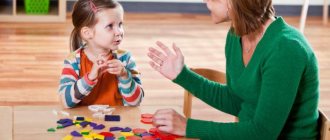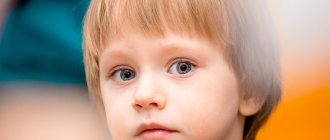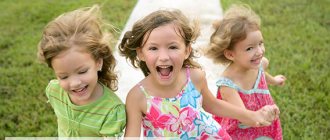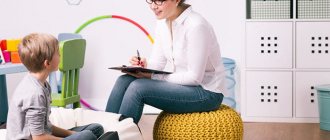When a child of 2-3 years old still does not speak, parents panic. It seems to them that if the neighbor's children speak very well, then their baby is behind in development. However, it is not. Speech therapists say that every child is individual. Non-verbal children can be taught at home. In this article you can familiarize yourself with exercises, tips and tricks that will help interest your child. You will learn why speech therapy classes for children are needed. 2-3 years is the age of interest in everything and curiosity. Therefore, you will not have any problems.
Speech therapy classes at home
Each child is individual. One starts talking early, the other starts talking late. Of course, all parents worry when their 2-year-old toddler doesn’t want to speak at all, but only points his finger. To prevent such incidents from happening, it is necessary to regularly conduct speech therapy sessions with children.
First of all, your child needs regular communication. In order for him to be interested in spending time with adults, he needs to interest the baby. Then speech therapy classes for children will be useful. 2-3 years is the age when a child should be able to speak at least some words. If this does not happen, then pay maximum attention to the exercises.
Most often, activities with children are based on imitation. Kids try to copy those around them. These are actions, words, gestures, facial expressions, etc. A 2-3 year old child is restless and does not know how to concentrate, so it is best to work with him when he wants it. First of all, parents need to achieve emotional contact with the child. When this happens, you can safely engage with your baby, play or just communicate.
Where to begin?
You need to make sure that the child is developing normally physically and emotionally.
There are conventional norms for the development of children (height, weight, skills, abilities, vocabulary of the child).
They should be taken into account, but you shouldn’t get hung up on discrepancies.
It is better to contact a specialist who will compare all the factors influencing development and give a professional assessment of your child’s development.
Warm-up: finger games
Few people believe that fine motor skills develop speech. However, this is scientifically proven. Therefore, try to pay attention to finger games. Here are some examples:
- Place your thumb and index finger together. Let the rest be raised and spread out. Show the children this cockerel, saying: “Our Petya the Cockerel, the golden comb, went to the market and bought one boot.”
- Close your thumb and index fingers and tap them on the table. At this time, say: “The chicken came and found a grain, did not eat it herself, but took it to the children.”
- Close the thumb with the two middle fingers, and simply bend the little finger and index finger slightly, saying: “The mouse is gnawing on the dryers, the cat has come, the mouse has crawled into a hole.”
- Bend your phalanges in different directions, saying: “Our fingers are very friendly, everyone needs them. We need to count the brothers, there are five of them on one hand. There are no less of them on the second, they are all good, because my fingers.”
Finger gymnastics is a warm-up that every child needs to get him interested in a further lesson. After all, speech therapy classes for children require perseverance. 2-3 years is the age of fidgets. Therefore, we first interest the baby, and then we begin the exercise.
Arsenal of specialists
The complex of activities of a speech pathologist with children includes onomatopoeic games, logorhythmics (speech exercises with the addition of movements), various games with objects, toys, and special aids. At the same time, a specialist can widely use a wide variety of materials: cards, thematic pictures, children's lotto, dishes, and use different types of activities.
- Fine motor skills are developed by assembling puzzles, mosaics, construction sets, and pyramids; building towers from cubes, painting with finger paints, rolling balls, nuts, ribbed pencils in your palms; doing modeling.
- Visual attention is sharpened with the help of cards, children's lotto, bright toys or pictures.
- Auditory skills are developed by all kinds of children's musical instruments or objects that make different sounds (spoon and glass, plastic bags).
- When carrying out breathing exercises, cotton wool, paper figures (butterflies, birds), soap bubbles, water and cocktail straws are used.
- To develop tactile sensations, objects with surfaces of different properties (metal, wood, fur, satin), finger puppets, and spiked balls are used.
Speech exercises must be carried out in front of a mirror so that the baby can see his movements and correlate them with the movements of the teacher.
We have already talked about what kind of exercises can be carried out in such cases:
- finger exercises and exercises for the development of phonemic hearing are described in detail here (exercises for speech development);
- logorhythmic exercises were discussed in this article;
- articulatory gymnastics for the development of speech and breathing organs were discussed here.
For a child of this age, it is very important to study in a familiar environment. Therefore, if it is not possible to invite a specialist to your home, organize similar classes for him at home. This way he will consolidate the acquired skills and get the feeling of an unfamiliar home, but of familiar actions. And this is also stability.
Articulation gymnastics
Before conducting speech therapy classes for children 2-3 years old at home, it is necessary to develop the muscles of the tongue. This is why articulation gymnastics is needed. It is advisable to carry it out together with the baby in front of the mirror:
- Let the child imagine that the tongue is a brush. His mouth should be slightly open. The tongue should be drawn across the palate towards the throat and back to the teeth.
- Exercise “Tongue on a swing”. At the same time, open your mouth wide. At this time, the tongue lies under the lower teeth. Then lift its tip under the upper teeth. This exercise must be done at least four times.
- "Delicious jam." You need to lick your upper lips first with your tongue, then move on to the lower lips. Do the exercise 5 times.
- Brush your teeth with your tongue. Open your mouth wide. Run the tongue first over the lower teeth, then over the upper teeth. Do this exercise 4-5 times.
This is how speech therapy classes for children (2-3 years old) are held at home. However, the child will have fun and interest only when you engage with the baby in the game, and not force him.
The role of the book
The book introduces the child to the world around him; develops logical and imaginative thinking, memory, imagination; expands vocabulary; teaches you how to write sentences correctly.
Through reading, a child learns to listen and concentrate.
Family reading is a way of communication between parents and children, a good method of education and a means of leisure.
Psychologists believe that children to whom their parents read books are more emotionally balanced and self-confident.
Onomatopoeia: who sounds? What's knocking?
When you have successfully completed finger and articulation gymnastics, you can begin to study sounds or syllables. To do this, you need to imitate the sounds of animals or objects with your child. Say the following phrases to your baby:
- “Our frog is the head of the swamp, sits on the sand and says: “Kva-kva.”
- “The cockerel was afraid to fall into the river and kept shouting: “Ku-ka-re-ku.”
- “My bell rings ding-ding all day long.”
- “The bunny gnaws the carrot appetizingly and creates a little noise: “Crunch-crunch.”
- “The rain says: “Drip, drip.” You need to take an umbrella with you.”
- “The horse runs merrily and clatters its hooves. This is not a boot, but the sound of a knocking “clack-clack-clack.”
- “The pig says: “Oink-oink, I’ll give you some candy.”
- “The clock gives us a sign of time and it sounds “tick-tock”.”
- “A steam locomotive travels around the world and repeats: “Too-too, I’m going.”
- “Anechka got lost in the forest and called out to her friends: “Ay-ay.”
Speech therapy classes for children (2-3 years old) at home are very useful and exciting. In a playful way, you and your baby can achieve great success.
Cost of speech therapist-defectologist services:
| Service | Price |
| Initial paid appointment with a children's speech therapist (diagnosis and consultation) | 2,500 rub. |
| Lesson with a child from a speech therapist-defectologist | 2,200 rub. (40 min.) |
| Lesson in combination with Forbrain | 2,500 rub. (40 min.) |
A speech pathologist-defectologist provides paid services in each of the four departments of our Center in Moscow, prices are indicated above. Every day from 10-00 to 18-30.
Logorhythmics
Such activities help children not only master speech, but also expand their vocabulary. Speech therapy rhythms develop a child’s motor skills, speech, thinking, memory, and attention. Exercises are given to children from two years old. When your child speaks poorly, let him repeat only what he remembers. If he does not speak at all, then the adult sings, and at this time the child’s hearing develops and his speech reserve is replenished.
Speech therapy classes for children 2-3 years old are interesting and exciting. When you start singing and doing the exercise, the child will become interested, and he will involuntarily begin to repeat after you. There are several exciting games:
- "For a walk". You need to read aloud a verse to which the baby repeats certain movements:
Our legs (stretches palms to legs)
walk along the path (slaps hands on knees).
Over bumps, and over bumps (moves in slow steps)
all the flowers step over (raises his legs high).
- Game "Weather". The child sits on a high chair and listens to slow music. When you say, “It’s raining,” he pats his knees with his palms in rhythm. Hearing the words: “Lightning has appeared,” the baby rings the bell. When you said: “Thunder is thundering,” the child stomps his feet loudly. When the word “silence” is said, the baby becomes silent and sits motionless for a minute.
- Do exercises, saying: “First, we raise our handles “one-two-three”, then we lower our handles. We'll stomp our feet, clap our hands, jump, run, and we'll finish our exercises. And we will begin to walk quietly again.”
These are interesting speech therapy classes for children 2-3 years old. Exercises should be carried out only with musical accompaniment. Then the child will really like such activities, and he will please you with his successes.
Norm or deviation?
How can parents understand that their child is lagging behind his peers in speech development? After all, we often tend not to attach importance to this: talk it out, everything has its time. First you need to compare his skills with the average for this age.
So, what does a baby normally achieve by the third year of life in terms of speech?
- In his vocabulary, the number of nouns from surrounding objects increases.
- The baby’s speech contains almost all parts of speech, which for the most part are used correctly and consistently.
- Sentences gradually become longer and longer, they already consist of 3-4 words.
- Onomatopoeias are used less and less instead of words.
- The baby’s active dictionary now contains about 200–300 words.
However, it often happens that the baby does not speak so actively, but this does not indicate significant problems, but only speaks about the individual characteristics of the child’s development. For example, he does not speak at all or says very few words, but at the same time:
- he has no diseases, disorders in the structure of articulatory organs, organs of vision and hearing, no brain injuries;
- the baby demonstrates the importance of communication for him;
- has no mental disorders;
- understands the speech of adults addressed to him;
- understands and fulfills requests, including complex ones (take a book from the shelf and bring it to dad);
- can show in the picture the object that adults named;
- distinguishes words that denote actions;
- actively uses facial expressions, intonation, and gestures in communication;
- knows how to express his emotions, empathize with others (hug, feel sorry).
In this case, they talk about individual development rates: if intellectual abilities are preserved, speech abilities usually follow, just a little slower than in other children. In this case, the child will only need speech therapy classes, preferably at home with his parents, in order to catch up with his peers and in the future be no different from them.
Games for hearing development
These activities are necessary for the child to develop hearing. Children must identify sounds. This could be the sound of rain, thunder, a dog barking or a cat purring, etc. Speech therapy classes with non-speaking children 2-3 years old should be carried out as usual. Remember, this is not a pathology, but most likely laziness, which needs to be overcome with the help of exciting exercises.
Let your baby listen to 2 sounds, for example, a baby crying and a vacuum cleaner running. Let the little one determine who or what is making the sound. When tasks are already easy for him, you can complicate the exercise. Let your baby listen to 3 different sounds, and then 4. If he is in no hurry to speak, then help him and do not scold the baby.
Speech imitation
A child’s reproduction of sounds, words, and phrases is called speech imitation.
It is meaningful only when speech is closely related to the child’s actions.
An adult should stimulate the child's speech with questions.
Words to be repeated must be pronounced many times; do not repeat the child’s “substitute words.” The child’s answers are accepted in any form.
The most important thing is to do everything possible so that the child does not hesitate to speak.
Speech imitation goes through several stages:
- Copying sounds that have a certain meaning.
- Repetition of amorphous words (kup-kup - swim, am-am - eat, lalya - doll).
- Repetition of simple words (baba, grandfather, drink).
- Repeating short phrases: “Give me the juice!” Where's the spoon?
Pay great attention to the use of verbs. If a child’s speech contains many action words, his level of development is quite high.
Games with speech imitation
An effective way to induce speech imitation is the use of poetic texts - finishing words and phrases by creating pauses when reading poetry.
For example:
They love... (monkeys) very much
Eat sweets... (bananas).
We are like monkeys... (look like)
And we love bananas... (too).
Gradually, the number of pauses (words skipped by adults) can be increased, thereby increasing the child’s vocabulary.
Fun games in the form of a conversation: an adult repeats a word several times, then asks the child a question, the answer to which is the highlighted word. If the question is answered correctly, the adult praises the child; if the question is answered incorrectly, he answers the question himself or offers several answer options.
Poems for speech development
Speech therapist classes for children 2-3 years old can be carried out by parents at home. If you practice with your baby every day, then he will start talking faster than you expect.
Poems are an integral part of speech development. It is important that there is a simple rhyme, then it will be more interesting for the child to practice:
- “There was a small fight in the river. Something was not shared between the two cancers.”
- “Our dear turtle always hides in her shell out of fear.”
- “Topotushki, topotushki, a bunny is jumping at the edge of the forest. He was tired and sat down and ate a carrot.”
Poems for children 2-3 years old are offered very small so that the child can easily remember them. When you see that the baby begins to recite small rhymes in full, then you can complicate the task.
What can you do at home?
In order to get a noticeable result, it is important to combine the efforts of the teacher and parents. You should not expect quick changes or rely only on the work of a speech therapist. Parents need to make extra efforts themselves at home.
You can carry out all the speech therapy exercises that are listed in the articles linked above, that is, develop fine motor skills, phonemic hearing, speech breathing, and articulatory apparatus. These articles contain many examples when exercises are performed completely unnoticed by the baby, he does not feel the “activity” (for example, blowing dandelions). You can come up with other options for such exercises. For example, blowing on paper boats in the bathroom or blowing soap bubbles. And the finger puppet theater will delight your little one and engage not only his fingers, but also his emotions and imagination.
It is important to consider the following.
- Much depends on your positive attitude and the same attitude towards your baby. Never lead him to think that he is flawed, sick, different from everyone else; Never scold for failures, but actively praise for the slightest progress.
- When communicating with a child, do not use “childish” speech: do not lisp, do not replace words with onomatopoeia (“kva-kva” instead of “frog”).
- Take into account the character traits and temperament of your baby when playing such games with him.
- Remember that results can only be achieved through systematic exercise, tailored to your child’s daily routine.
- Feel free to consult with your speech pathologist about what specific exercises are important to perform at home in order to achieve noticeable positive changes.
- Involve your child in activities: don’t just talk, but give him the opportunity to express himself creatively (sculpt, draw, dance, play a role), and help you around the house, even in small things.
- Push the boundaries of his independence: teach everyone new self-service skills (although this is often difficult), while showing maximum patience.
- Before starting classes, pay attention to the mood and general condition of the baby. If he is unhealthy, there will be no benefit from the exercises; the baby will only get tired and upset. If he is in a bad mood, find a way to cheer your child up and get him in the right mood.
And most importantly: if a child has speech disorders at such an early stage, you need to be patient, surround the child with positivity, create a trusting relationship with the baby (sometimes a consultation with a child psychologist may be required - this should not be neglected). After all, if you start working on correction after 4 years, a lot will be irretrievably lost. And now it is important to understand: the result will come. Slowly, but certainly. If you don’t give up, practice systematically, trust your speech therapist, believe in success and love your baby, accepting him for who he is.
Pure talk
They are also necessary for the development of the baby’s speech. Pure sayings, like poems, should be short and easy to remember:
- “Oh-oh-oh – our cat isn’t so bad.”
- “Uh-uh-uh - our rooster crowed.”
- "Ah-ah-ah - we are standing on our feet."
- “Sha-sha-sha – mom’s noodles turned out delicious.”
- “Shu-shu-shu - I’ll ask daddy.”
- “Shi-shi-shi - how the reeds rustled.”
You can come up with such pure sayings yourself. It all depends on which letters the baby cannot pronounce.
Individual approach
Experts recommend classes with a speech therapist from the age of 2; contacting a specialist is necessary if you suspect SRD (speech development delay). Timely speech therapy diagnosis of problems in speech development, and subsequently regular corrective speech therapy classes, can help the child adapt more easily to kindergarten and eliminate difficulties in communicating with peers and adults.
To create comfortable conditions, the children's speech therapist uses specially selected games and various teaching aids for performing exercises. It is advisable to include parents in the correction process in order to speed up the receipt of results (parents will help the child reinforce the material recommended by the speech therapist at home).
Advice from speech therapists
Nowadays, it is very common to find non-speaking children aged 2-3 years. This does not mean that the child has speech problems. Speech therapists say that there is no need to worry until the age of three. However, speech therapy classes for children still wouldn’t hurt. 2-3 years is an inquisitive age, so kids will be happy to exercise if they are interested.
The first few lessons should last no more than 3 minutes. Then you can gradually increase the time. It is important that the baby likes it. If you see that your child is tired and doesn’t want to study, don’t force him. Postpone the exercises until your baby is in the mood for exercise.
It's better to exercise a little every day. Then the baby develops skills, habits and memory. Don't scold him for incorrect movements and pronunciation. Remember, your baby is just learning. Don't discourage him from studying. After all, if you scold and punish, then nothing good will come of it.
What can cause speech problems?
Conventionally, the causes of such problems can be divided into physiological, social and psychological.
In the first case, we are talking about various problems with the course of pregnancy (maternal illness, infections, gestosis, Rh conflict, fetal hypoxia, etc.), difficulties in childbirth (entanglement of the umbilical cord, use of forceps, rapid labor, use of labor stimulation, birth injuries of the child ).
But this is not always the reason for deviations or lags. Psychological factors and so-called social neglect often play a role. Therefore, it is worth considering in more detail all aspects that may cause problems with the child’s development in the future.
Physiological causes of speech delay (as a result of difficult pregnancy or childbirth):
- hypotonicity or hypertonicity of the facial muscles;
- hearing diseases, hearing loss;
- anomalies in the development of articulation organs (palate, tongue, lips);
- pathologies of brain and nervous system development - neurological diseases;
- hereditary diseases;
- mental disorders (in particular autism).
Psychological causes of a child’s speech problems:
- severe fear;
- nervous, tense situation in the family, frequent strong scandals;
- single-parent family;
- stepfamily (or upbringing with grandparents, aunts);
- asocial parents (alcoholics, drug addicts, leading a “morally free” lifestyle).
Social reasons:
- insufficient attention to the baby (or its complete absence) from parents;
- the child constantly spends time at the computer, TV, tablet, playing on the phone;
- overprotection on the part of adults (the child does not need to say anything - any whim is understood and carried out “with half a sound”);
- excessive demands on the child from the parents, constant humiliating comparisons with more successful children, attempts to forcefully teach them to speak.
From the above it is clear how many factors you yourself can exclude in order to provide your child with normal conditions for development. Therefore, you should seriously think about your behavior even before the baby is born, evaluate all the prospects for him and promptly change the situation for the benefit of your child, if necessary. A child should grow up in an atmosphere of love, peace, harmony, security and care.
Game "Fold the picture"
This game is used as a transition from one activity to another. And also as a sensory respite. It consists of the simplest action, you need to assemble a picture from parts. And this is where problems arise. Nowadays, puzzles are very common, and this is wonderful, but puzzles, unfortunately, do not always take into account the visual perception of the picture. This sometimes simply turns into selecting a suitable figure, and not into understanding why this particular piece needs to be placed here. To develop visual analysis and synthesis, you need to collect cut-out pictures, in addition to puzzles.
Where can I get them? Of course, you can buy ready-made ones, but you can make them even simpler. Cut the cover of a notebook, album, folder from colored paper or cardboard into the required number of pieces. And the picture is ready.
If the child has never collected such pictures, you need to start with two parts with a large picture, then increase to 3-4 or more and complicate the picture. You can also cut the parts not into squares, but into triangles.
When a child is good at assembling cut pictures from four or more parts, you can give him cubes.
And be sure to name who or what happened. And if the child has already begun to speak in phrases, we compose a phrase.
About the author: Ekaterina Mrachkovskaya , speech therapist-defectologist, speech therapist via Skype, consultant, owner of a private speech therapy office in Sarov, Nizhny Novgorod region.
Would you like to learn more about games and exercises to develop children's speech? Register for a free webinar by the author of the article - Phonemic hearing and phonemic awareness . Webinar for primary school teachers, educators, aspiring speech therapists and parents. Waiting for you!









